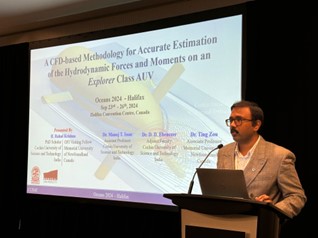Rahul Krishna H. is a final year doctoral research scholar at the Department of Ship Technology, Cochin University of Science and Technology (CUSAT), in Kochi, Kerala, India. As part of the OFI Visiting Fellowship program, Rahul investigated the numerical self-propulsion analysis of the Explorer class AUV at the Memorial University of Newfoundland, Canada. Keep reading to learn more about this exciting project!
What were the main objectives of your project?
Autonomous Underwater Vehicles (AUVs) are unmanned robotic platforms that operate beneath the ocean surface and are capable of carrying various payloads for scientific and military applications. The goal of this project was to analyse the self-propulsion characteristics of AUVs and generate data that will be valuable for developing future designs, in particular calculating power requirements for the AUV’s propeller, ultimately aiding in decisions regarding payload capacity.
Memorial University has one such AUV – the Explorer. The AUV initially had a length of 4.5 metres (m), which was later upgraded to 5.3 m to meet enhanced mission requirements, resulting in a change in the length-to-diameter ratio. Self-propulsion, defined as the vehicle's ability to move forward using thrust generated by its propeller, is a critical performance characteristic. One key aspect of self-propulsion is estimating the self-propulsion point, which represents the propeller's rotation rate at which the thrust equals the vehicle's drag. Under the guidance of Dr. Neil Bose (President and Vice-Chancellor pro tempore, Memorial University) and Dr. Ting Zou (Associate Professor, Memorial University), my investigation focused on two main aspects of this AUV:
- Numerical Self-Propulsion Analysis:
First, I conducted a numerical self-propulsion analysis for both the original (4.5 m) and upgraded (5.3 m) configurations of the Explorer AUV. Simulation results were compared with sea trial data obtained from the same AUV to validate findings. Computational Fluid Dynamics (CFD) software was used to analyze the flow physics around the AUV at various speeds and propeller rotation rates during the self-propulsion analysis. - Effect of Length Variation on the Self-Propulsion Point:
Second, I studied how changes in vehicle length impact the self-propulsion point, which in turn influences the propeller's power requirements. Understanding this relationship is essential for optimizing payload capacity and making informed design decisions.
What were the key activities in this project?
In the beginning of the fellowship, I visited the Explorer AUV facility at the Holyrood Base in St. John’s, Newfoundland to take note of the vehicle dimensions and changes in the new configuration of the AUV compared to the previous version. As part of my research, I modeled these configurations so that I could analyze the self-propulsion capabilities of the Explorer. Further, I generated self-propulsion data for the old and new configurations of the Explorer AUV operating at various speeds and propeller rotation rates using Computational Fluid Dynamics (CFD) software. Next, I used this data to predict how the AUV would perform. I shared my expertise on numerical self-propulsion analysis with research students working on the Explorer AUV research team.
While at Memorial University, I also had the opportunity to visit the Fisheries and Marine Institute to view their ROVs and underwater vehicle simulator labs. Through, Jungyong (John) Wang, Senior Research Officer at the National Research Council (NRC) Canada, I also had the opportunity to witness an experimental self-propulsion test on a icebreaker ship model at NRC.
What were the key research outputs from this research?
As part of this project, I co-authored a paper with Dr. Manoj T. Issac, Dr. D. D. Ebenezer, and Dr. Ting Zou titled “A CFD-based Methodology for Accurate Estimation of the Hydrodynamic Forces and Moments on an Explorer Class AUV.” Published by the IEEE Xplore, the paper delves into the effective use of Computational Fluid Dynamics and Semi-Empirical methods to estimate the hydrodynamic forces and moments acting on the Explorer AUV under various operational conditions. I had the opportunity to present this paper during the recent OCEANS 2024 conference held in Halifax, Canada, representing both CUSAT and Memorial University.
This research was a collaborative effort between my home institution, the Cochin University of Science and Technology (CUSAT), in India, and Memorial University in Canada. My visit here was a significant milestone in fostering this collaboration between both universities, with the potential for future funding opportunities, joint post-doctoral programs, and combined research publications.
What are the next steps for this research?
With my knowledge and expertise in Computational Fluid Dynamics, I hope to assist the Explorer AUV research team at Memorial University in making future vehicle performance predictions. Such predictions will help to conduct sea trials more effectively and safely.
Rahul Krishna H. is a Computational Fluid Dynamics (CFD) analyst. Rahul has completed his Bachelor of Technology and Master of Technology degrees in Mechanical Engineering from CUSAT, India. Currently, he is a researcher at the Computational Hydrodynamics and Structural Engineering Laboratory (CHASE Lab) at the Department of Ship Technology, CUSAT. His research interests focus on the design and CFD analysis of underwater vehicles, submarines, and AUV hydrodynamics. He has delivered technical presentations in multiple seminars globally and holds positions on editorial and review boards of several journals. He has published research articles in peer-reviewed journals and at international conferences.


